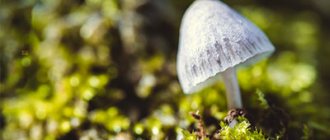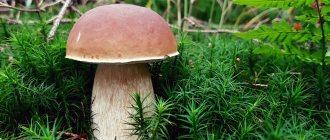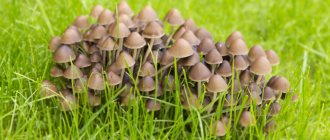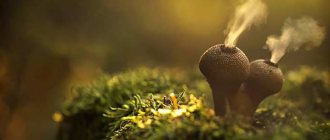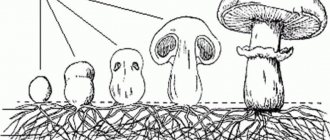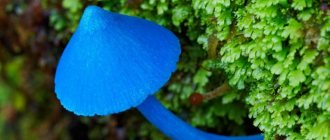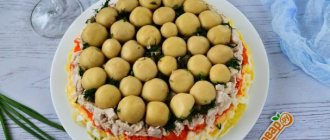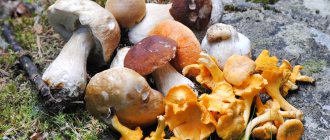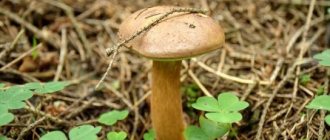Mushrooms
0
1663
Article rating
Kira Stoletova
There is a type of fungi that feeds on dead remains, and there are those that consume the nutrients of living organisms. Saprophytic fungi settle and feed on the remains of animals or plants (scavengers), or excrement.
Description of saprotrophic fungi
Soil saprotrophs
An important ecological group of fungi are soil saprotrophs. Their mycelium is located in the humus layer of soil under the litter. Thus, humus decomposes into simpler components that improve forest soil. Classic soil saprotrophs are different types of champignons, many of which are edible.
The mycelium of many soil saprotrophs interacts in a certain way with the root systems of plants, most often woody ones, forming a complex structure - mycorrhiza.
All of the above mushrooms perform the function of forest orderlies. In the course of their life activity, they decompose dead plants, thereby cleaning the forest and enriching the soil with organic material necessary for the development of living plants.
Related materials:
Bacteria are present everywhere: in water, air, soil, in mountainous areas and even hot geysers. They can choose plants, animals and even humans as their habitat. Bacteria have a very small size and various shapes, due to which they can penetrate even the most inaccessible places and are resistant to temperatures and other unfavorable living conditions. According to the method of nutrition, they are autotrophic and heterotrophic. The latter, in turn, are divided into saporotrophs (saprophytes) and symbionts. Let's take a closer look at saprophyte bacteria.
Interaction
Saprotrophic bacteria are an essential part of any microbial community, which includes parasitic microorganisms, lactic acid fermenters, and in some cases fungi.
For example, we can consider the human intestinal microflora. Healthy microflora, which ensures normal food processing, consists mainly of lactic acid bacteria. They create an environment in the intestine that inhibits the saprotrophs and parasites present.
But as soon as the required amount of lactic acid ceases to be produced in the intestines, favorable conditions appear for the nutrition, growth and reproduction of putrefactive microflora, which immediately begins to poison a person with the products of their vital activity, which entails severe damage.
Features of mushrooms
Saprotrophs, like many bacteria, are decomposers that destroy the dead remains of living organisms. Unlike detritivores (representatives of the animal world that feed on decaying organic matter), they do not leave excrement in the process of life.
They are found everywhere, but there are especially many of them in the upper soil layers, incl. in the litter, they are present in fallen leaves, rotten wood, straw and even in conifer cones.
By extracting nutrition from dead organic material, they form a range of digestive enzymes:
- Amylases: break down carbohydrates;
- lipases: interacting with lipids;
- Proteinases: break down proteins.
Most saprophytes are characterized by chemotropism - the growth of mycelium towards the highest concentration of nutrients under the influence of chemical compounds.
Depending on the species, saprotrophic mushrooms may look like ordinary ones, have hyphae, and be divided into a cap and a stalk. In some of them, the division is not clearly expressed or may be absent.
There are unicellular and multicellular representatives. The former are microscopic in size; their single cell contains from one to several nuclei.
Saprophytic bacteria
Bacteria are such small organisms that they can only be examined with the most powerful microscopes, magnifying hundreds of times. And although in ordinary life a person is not given the opportunity to see them, he has to deal with the results of their activities every day. Thus, thanks to them, the existence of fermented milk products and wine is possible. And while some bacteria cause infectious diseases, others are of great benefit to humans.
Among them are, for example, some E. coli and bifidobacteria that live in the human digestive tract. They help the body absorb nutrients and fight pathogenic flora.
Mushrooms are parasites
Unlike fungi, which perform useful activities, parasitic organisms do not benefit the host plant, but destroy it during their lifetime. Tree infection occurs through damaged bark. Fungal spores, transported by air flow, penetrate through bare areas and settle on wood.
Appearance and nutrition
Parasitic fungi are either annuals or perennials that can live up to 25 years. Different species of individuals differ from each other in color, shape, structure, size and life expectancy. The shape of the fruiting bodies is hemispherical or cap-shaped, and also similar to a hoof or the tip of a pike. There are also shapeless growths in the form of convex or layered bodies. Perennials are capable of gaining up to 10 kg of weight and growing to a size of one meter. The color spectrum of parasites is also diverse. The structure of the body is similar to wood or soft skin.
Some parasites are able to adapt well to the host, stimulating its development in the initial stage. They feed on the growths formed, without developing mycelium inside the tree.
Edible types of parasitic mushrooms
Cap mushrooms are usually classified as saprotrophs. Less common are parasites, such as honey fungus. Entering into symbiosis with the root system, the fungi penetrate it with mycorrhizae, entwining the root processes.
The presence of a ring on the stem of the honey fungus formed the name of the mushroom. Prefers to grow in large colonies. It is salted, fried, pickled. Valued for its high mineral content. Just 100 grams of product contains the body’s daily need for these elements.
Since honey mushrooms cause wood rot, they are dangerous parasites. The black laces of the mycelium penetrate the bark and, releasing toxic substances, affect the wood. As a result, a young tree may die within 1-3 years. The old specimen dies after 10 years. Once a fungus settles on a tree, its growth slows down. The protective substances that the tree produces cannot stop the process, but only slow it down.
A parasitic fungus that feeds on tree sap is the tinder fungus. There are several varieties of this population. Although there are very few poisonous representatives, they are mainly used in cooking due to their solid body. Some species are considered delicacies. The sulfur-yellow tinder fungus tastes like chicken meat. In some countries, tinder fungi are specially cultivated on farms.
Reproduction
This parasitic fungus can reproduce both asexually and sexually. This fact makes it very tenacious, quickly spreading in nature and dangerous.
How does it reproduce?
In primarily asexual reproduction, mucor reproduces through spores. Threads emerge from the mycelium, which at the end have black heads with seeds. When the spores ripen, the head bursts under the influence of dampness and heat and they are carried by the wind over long distances throughout the area. If conditions are favorable, mold attaches and germinates, forming a mycelium.
During sexual reproduction, two branches of mycelia merge and form a diploid zygote. In humid and warm conditions it germinates into a hypha. The sporangium is born on the hypha.
The role of saprotrophs in human life
This type of bacteria plays a very significant role in the cycle of nature. At the same time, the objects for their nutrition are things that are, to one degree or another, important for humans.
Saprotrophs play a very important role in the processing of organic residues. Since any organism dies at the end of its life, the nutrient medium for these microorganisms will exist continuously. Saprophytes produce, in the form of products of their vital activity, many constituent substances necessary for the nutrition of other organisms (fermentation processes, transformation of sulfur, nitrogen, phosphorus compounds, etc. in nature).
Associate Professor, Candidate of Medical Sciences – Victoria Vladimirovna Dvornichenko:
It is not for nothing that mushrooms are considered a real miracle of nature, as they have special distinctive features. But, despite the similarities, representatives of this kingdom also differ not only in appearance, but also in the way they feed.
Saprotrophic organisms (decomposers) are necessary for the environment, as they contribute to the faster decomposition of plant and animal remains. At the same time, they do not leave solid waste, that is, they do not pollute the environment. Mushrooms are typical decomposers; they close the small cycle of substances in nature.
Features of structure and nutrition
The appearance of saprophytes is very diverse. They can be higher:
- tubular;
- marsupials;
- lamellar.
And imperfect:
- Yeast;
- mold.
The first ones may look like ordinary mushrooms, which are known to everyone. They consist of cells that are huge in size (hyphae) and have several nuclei. Together they form plectenchyma, which are divided into distinct parts: a stalk and a cap. However, in some representatives they may be absent or may not have clear boundaries. The watery pulp is covered with a skin that protects from external irritants.
Saprotrophs, like other representatives of the fungal kingdom, feed only on ready-made substances
Volumetric consists of many thin branches, which is part of the mycelium
. The color varies, mostly white, beige, yellow and red-brown.
And if among the higher representatives there are edible species, then imperfect ones are unsuitable for food. Some are used in the preparation of dishes and drinks, and their hazardous properties are neutralized due to storage conditions or further processing. They differ from “traditional” mushrooms in a completely different structure.
Most of the body is represented by mycelium, which is well developed in mold and yeast. Consists of multinucleated cells and septa. As a result of mitosis, conidia are formed on the mycelium. These are immobile spores of brown, white, milky or gray color. Shape: spherical, star-shaped, spiral or thread-like, but it is almost impossible to see with the naked eye.
Saprotrophic organisms (decomposers) are necessary for the environment, as they contribute to faster decomposition of the remains of plants and animals
Saprotrophs, like other representatives of the fungal kingdom, feed only on ready-made substances. Like other heterotrophs, their bodies are unable to produce organic ingredients from carbon dioxide, water and sunlight. The food source for saprophytes are:
- Leaves and needles;
- remains of trees, their branches and trunks;
- animal remains, such as horns, feathers and fur;
- straw.
With the help of mycelium, organisms extract nutritional ingredients from the substrate. The peculiarity is that they do not cause any harm to the environment (with the exception of imperfect representatives if a person or animal eats contaminated food).
Examples of saprophyte fungi
Edible:
- Champignons
are one of the most common saprophytic mushrooms, the family of which includes the following species: umbrellas, puffballs, dung beetles, cystoderms. They have a pleasant and delicate taste. - Morels
belong to the Morschella family. They are named so because of their memorable appearance: the cap of morels resembles the pulp of a walnut or prune. - The line
is from the discine family. - Cobweb
- prefers swampy areas.
All mushrooms must be thermally processed. A person who has consumed a raw product may become poisoned.
Everything you need to know about mushrooms (video)
There are not so many species suitable for food, but after appropriate heat treatment they completely lose all their negative properties.
Physiological processes
Saprotrophs, as one of the most numerous groups, have in their ranks representatives with very different physiological needs:
- Anaerobes. For example, we can consider E. coli, which carries out its life processes without the participation of oxygen, although it can live in an oxygen environment.
- Aerobes are bacteria involved in the decomposition of organic matter in the presence of oxygen. Thus, putrefactive diplococci and three-membered bacteria are present in fresh meat. At the initial stage, the content of ammonia (a waste product of putrefactive microflora) in meat does not exceed 0.14%, and in already rotten meat – 2% or more.
- An example of spore-forming bacteria is Clostridia.
- Non-spore-forming bacteria are Escherichia coli and Pseudomonas aeruginosa.
Despite the diversity of physiological groups, united according to the characteristics of saprophyte, the final products of the activity of these bacteria have almost the same composition:
- cadaveric poisons (biogenic amines with a strong unpleasant cadaveric odor; as such, the toxicity of these compounds is low);
- aromatic compounds such as skatole and indole;
- hydrogen sulfide, thiols, dimethyl sulfoxide, etc.
Of all the listed decay products, the most dangerous and toxic to humans are the latter (hydrogen sulfide, thiols and dimethyl sulfoxide). They cause severe poisoning, even death.
Heterotrophs
In biology, heterotrophs are organisms that receive nutrients from prepared foods. Unlike autotrophs, heterotrophs are not able to independently form organic substances from inorganic compounds.
Examples of heterotrophs in biology are:
- animals from protozoa to humans;
- mushrooms;
- some bacteria.
The structure of heterotrophs suggests the possibility of breaking down complex organic substances into simpler compounds. In single-celled organisms, organic substances are broken down in lysosomes.
Multicellular animals eat food with their mouths and break it down in the gastrointestinal tract with the help of enzymes. Fungi absorb substances from the external environment like plants.
Organic compounds are absorbed along with water.
According to the source of nutrition, heterotrophs are divided into two groups:
- consumers - animals that eat other organisms;
- decomposers are organisms that decompose organic remains.
According to the method of feeding (food absorption), consumers are classified as phagotrophs (holozoans). This group includes animals that eat organisms in parts. Reducers are osmotrophs and absorb organic substances from solutions. These include fungi and bacteria.
Heterotrophs can use living and non-living organisms as food. In this regard, the following are highlighted:
- biotrophs - feed exclusively on living creatures (herbivores and carnivores);
- saprotrophs - feed on dead plants and animals, their remains and excrement.
Biotrophs include:
- phytophages - animals that feed on plants (horse, grape snail, bees);
- zoophages - animals that use other animals for food (fox, spider, octopus);
- Parasites are organisms that use the host’s body for food without killing it (roundworms, mites).
Rice. 1. Biotrophs.
Saprotrophs include animals that eat corpses (hyenas, vultures, Tasmanian devils) or excrement (fly larvae), as well as fungi and bacteria that decompose organic remains.
Some living things are capable of photosynthesis, i.e. They are both autotrophs and heterotrophs at the same time. Such organisms are called mixotrophs. These include the eastern emerald elysia (mollusk), cyanobacteria, some protozoa, and insectivorous plants.
Multicellular animals are consumers of several orders:
- first - they feed on plant foods (cows, hare, most insects);
- second - they feed on consumers of the first order (wolf, owl, human);
- third - they eat consumers of the third order, etc. (snake, hawk).
One organism can simultaneously be a consumer of the first and second or second and third order. For example, hedgehogs mainly eat insects, but will not refuse snakes and berries, i.e. Hedgehogs are simultaneously consumers of the first, second and third order.
Rice. 2. Example of a food chain.
Yeasts, fungi and heterotrophic bacteria are divided into three types according to their feeding method:
- saprophytes - use waste products and decaying tissues of animals and plants (most bacteria) as food;
- symbionts - are in a close positive relationship with other organisms (human E. coli, porcini mushrooms and oak);
- parasites – feed at the expense of another organism, causing damage to cells and tissues (dysentery bacillus, Koch bacillus, ergot).
Rice. 3. Saprophyte mushrooms.
Saprophytes play an important role in the cycle of substances and are decomposers in the food chain. Thanks to decomposers, all organic remains are destroyed and turned into humus - a nutrient medium for plants.
Viruses are neither heterotrophs nor autotrophs, because have the properties of inanimate matter. They do not require nutrients to reproduce.
Heterotrophs feed on ready-made organic substances, which they obtain by eating other organisms - plants, fungi, animals.
Decomposers that decompose organic remains include fungi and bacteria.
Average rating: 4.5. Total ratings received: 105.
Saprophytic plants
Although plants are classified as autotrophs (that is, they create their own nutrition using sunlight), this does not prevent many of them from being saprophytes to some extent. To survive, they need additional organic matter from the soil.
Among the plants, saprophytes include pineapples, orchids, begonias and some cactiaceae, as well as many mosses, ferns and algae.
Friends-enemies and enemies-friends
There are at least two reasons why it is advantageous for endophytes to exist without damaging the cells of the host plant:
- The destruction of cell walls would cause a strong immune response in the plant, aimed at rejecting tissues colonized by endophytes.
- The reproduction of most endophytes is associated with the reproduction of the host plant: either within vegetative organs or through the ovary and seed.
Consequently, the life activity of endophytes is associated with the life activity of plants, and they usually adhere to the strategy of “not cutting the branch on which they are sitting.” However, a peaceful dynamic equilibrium with its endophytes is possible only in the absence of strong stress influences on the plant. Under stressful conditions, some endophytes do not hesitate to switch to a parasitic lifestyle and “finish off” their partner. For example, one study showed that under conditions of normal mineral nutrition, perennial chaff seedlings colonized by the endophytic fungus Neotyphodium lolii better absorb mineral salts and have greater biomass, while with a lack of minerals, seedlings colonized by endophytes, on the contrary, develop worse and die more often than uninhabited ones.
Among the endophytes of the genus Epichloë, some species develop asymptomatically, while others, during the transition to sexual reproduction, can form mycelium that rings the stem from the outside - the so-called sheath disease of cereals (Fig. 2).
Figure 2. Epichloë mycelial “sheath” on the stem
Mycelial sheaths do not prevent the growth of vegetative shoots, and even, on the contrary, stimulate their growth, however, in some species they suppress flowering. However, most studies have not found a significant effect of sheath disease on the productivity of infected plants. The harmfulness of sheath disease is due precisely to the danger of poisoning farm animals when eating infected fodder grasses. It is believed that the more plant-friendly Neotyphodium species originate from Epichloë species that have lost the ability to reproduce sexually and form “cases.” In gratitude for this “gentle treatment,” the grasses “allow” Neotyphodium hyphae to penetrate the seeds and thus colonize the daughter plants.
In general, the boundary between mutualism and parasitism of endophytes, as often happens, is very blurred. Some types of fungi that are considered typical phytopathogens, for example, the same ergot - Claviceps actually balance on the verge of parasitism and mutualism in the plant. On the one hand, its hyphae spread into the ovary and kill the embryo, on the other hand, it feeds generally biotrophically, that is, without damaging the cells, and does not lead to the death of the host. Moreover, ergot destroys the ovaries of cereals only in some flowers of a small number of plants, and at the population level this may be beneficial. After all, the ergot poison accumulated in the sclerotia turns out to be so strong that a small amount of it in the grain is enough to “knock down” an entire herd and protect the entire plant population from being eaten by large mammals. In place of destroyed ovaries, ergot forms sclerotia - dark elongated formations of densely woven mycelial threads, from which, under favorable conditions, fruiting bodies of a rather “alien” appearance subsequently grow (Fig. 3). It is very likely, by the way, that ergot sclerotia are the same “chernushki” that Baba Yaga ordered Vasilisa the Beautiful to clear the wheat from in the fairy tale of the same name.
Figure 3a. Ergot sclerotium in a wheat ear
Figure 3b. Germination of fruiting bodies from sclerotium
"Top 10 most poisonous mushrooms in the world"
Widespread phytopathogenic fungi of the river. Fusarium cause plant diseases such as fusarium head blight, snow mold, fusarium wilt, root rot, etc., and produce dangerous toxins: deoxynivalenol, zearalenone, T-2-toxin, etc., which are necessary for fungi so that herbivores do not eat them along with a plant or with its seeds, until they slowly eat these plants themselves... Nevertheless, even among these insidious swallowers there are species that have turned from a parasitic or saprotrophic lifestyle to a relatively peaceful endophytic existence. For example, an isolate of F. oxysporum, an endophyte of the banana tree (Musa spp.), was found that does not cause fusarium symptoms in the host plant, but is toxic to the parasitic nematode Radopholus similis.
Ecological groups of fungi
Soil mushrooms
Soil fungi are involved in the mineralization of organic matter, the formation of humus, etc. This group includes fungi that enter the soil only during certain periods of life, and fungi of the rhizosphere of plants that live in the zone of their root system.
Specialized soil fungi:
- coprophylls - fungi that live on soils rich in humus (dung heaps, places where animal droppings accumulate);
- keratinophylls - fungi that live on hair, horns, hooves;
- xylophytes are fungi that decompose wood; among them, they distinguish between destroyers of living and dead wood.
Aquatic mushrooms
Among them are saprophytes that live on plant debris, parasites of aquatic animals and plants, as well as fungi that cause fouling of wooden parts of ships, piers, etc.
Cap mushrooms
Cap mushrooms settle on forest soil rich in humus and obtain water, mineral salts and some organic substances from it. They get some of their organic matter (carbohydrates) from trees.
The mycelium is the main part of every mushroom. Fruiting bodies develop on it. The cap and stem consist of mycelium threads tightly adjacent to each other. In the stem, all the threads are the same, and in the cap they form two layers - the upper one, covered with skin, colored with different pigments, and the lower one.
In some mushrooms, the bottom layer consists of numerous tubes. Such mushrooms are called tubular. In others, the lower layer of the cap consists of radially arranged plates. Such mushrooms are called lamellar. Spores form on the plates and on the walls of the tubes, with the help of which the fungi reproduce.
The hyphae of the mycelium entwine the roots of trees, penetrate them and spread between the cells. A cohabitation that is beneficial for both plants is established between the mycelium and plant roots. The fungus supplies plants with water and mineral salts; By replacing root hairs on the roots, the tree gives up some of its carbohydrates to it. Only with such a close connection of the mycelium with certain tree species is the formation of fruiting bodies in cap mushrooms possible.
Symbiosis
This method of interaction is quite widespread in nature, although it is very specific. The two organisms use each other's features and mutually benefit. Cap species often enter into symbiosis with trees in the forest. Their mycelium envelops the roots of the plant and penetrates the cells. Its area reaches 1-6 km² and even more.
The hyphae absorb minerals and share them with the tree. Thus, almost the entire periodic table comes to him. The suction surface of the roots increases, which stimulates the growth of oak, birch, aspen or other species. Some trees cannot even exist without their helpers; the villi of their roots atrophy.
The fungus receives organic substances from the tree in large doses, which it synthesizes in the light through photosynthesis. Often these compounds enter the mycelium in a simple form accessible to cells.
Irina Selyutina (Biologist):
The mutually beneficial cooperation between a fungus and a plant is called mycorrhiza or fungal root. This term was introduced into biology in 1885 by the German biologist A.B. Frank.
The following types of mycorrhiza are distinguished:
- Ectomycorrhiza: fungal hyphae entwine the root, forming a sheath, but do not penetrate the root cells, but only into the intercellular spaces.
- Endomycorrhiza: fungal hyphae penetrate into root cells through pores in the cell membranes and can form clusters there that resemble tangles. Hyphae within the cell can branch; these branches are called arbuscules.
- Ectoendomycorrhiza: represents an intermediate option between the previous ones.
As a result of these normalized mycorrhizal relationships, species are more likely to survive natural competition.
Lichens
The symbiosis of fungi and algae gave rise to a special type of organisms - lichens, which belong to the kingdom Mushrooms. They are sometimes mistakenly called autotrophic fungi. But as part of lichens, the fungus continues to feed heterotrophically.
Irina Selyutina (Biologist):
The body of lichens is called slang and consists of fungal hyphae and unicellular algae. The algal component is also called a phycobiont; it can be represented by cyanobacteria, green or yellow-green algae. The fungal component is a mycobiont, usually represented by marsupial and basidiomycetes. In this original organism, the fungus supplies the algae with water and minerals, and the algae, in turn, synthesize organic compounds. Despite the seemingly mutually beneficial union of two representatives of different kingdoms, they talk about such a phenomenon as obligate parasitism on the part of the fungus, because if this relationship is destroyed, the algae will survive in an independent life, but the mushroom will die.
The photosynthesis component in this tandem is carried out by algae, which receive minerals from their “partner”. Fungal hyphae attach to the substrate (soil, tree bark) and absorb water and ash elements from there and transfer them to algae. They produce organic matter from carbon, hydrogen and nitrogen, which the fungi then use.
Nutrition method
For the normal functioning of any living organism, proteins (proteins), carbohydrates and fats (lipids) are necessary. Proteins are synthesized in cells from amino acids supplied to heterotrophs from the external environment. Fats are part of cell walls and become an energy reserve in case of carbohydrate deficiency. Complex carbohydrates are obtained from glucose and are energy sources. Plants synthesize complex carbohydrates from simple carbohydrates - starch and fiber. In animals they turn into glycogen, here fungi are completely similar to fauna, glycogen is also present in their body.
To obtain all these substances from the external environment, they must first decompose more complex compounds into simpler ones. After all, neither peptides, nor starch, nor fiber enter the cell. To do this, organisms release enzymes into the external environment. Some representatives of the kingdom, for example, yeast, do not have enzymes. Therefore, they live on a specific substrate of simple carbohydrates, which penetrates the cell walls.
Complex multicellular higher fungi synthesize enzymes in the mycelium, and some species also in fruiting bodies. Each variety has its own characteristics. Some produce enzymes that can dissolve a large number of substances. Others have only specific ones, for example, breaking down only keratin. This determines what medium they will grow on.
The body of multicellular species consists of special threads - hyphae. It is through their cells that nutrients are absorbed. Protein synthesis, the conversion of glucose into glycogen, and simple lipids into complex fats occur here. Hyphae are attached to the substrate. Depending on what environment and method of nutrition mushrooms choose, they are divided into:
- saprophytes or saprotrophs;
- parasites;
- symbiotics or symbionts.
Most representatives of the kingdom are saprophytes that settle on decaying remains. But there are thousands of parasitic species. Some have chosen a special way of interacting with other organisms - mutually beneficial symbiosis. Such mushrooms do not feed only at the expense of another organism, but help it obtain chemical elements from the external environment. This is their main difference from parasites.
Saprophytic mites
These small organisms are our constant neighbors, living in house dust. They are found in large quantities right in our bed - in pillows, mattresses and blankets. By themselves, they are incapable of causing harm, since they do not bite humans and are not carriers of any infections. However, their waste products can be dangerous for people with allergies.
Saprophytes and parasites are capable of completely restoring their population in a short period of time, so you should not pursue methods that promise to completely get rid of them. If you follow basic hygiene procedures (washing clothes, timely replacement of mattresses and pillows, wet cleaning of the room), you can maintain the number of harmful saprophytic mites at a level that is relatively safe for health.
